This exhibition accompanies the Church Commissioners’ public report on historic links between Queen Anne’s Bounty (one of the Church Commissioners’ predecessors) and transatlantic chattel slavery.
Letters, books and documents from our collections are displayed to show some of the links between the Church of England and transatlantic slavery. Amongst these are rare documents from enslaved people, contrasting views on the rights of enslaved people from within the Church, and from missionaries working in the Caribbean and the Americas. These documents also present the arguments put forward using the Church’s teaching at the time both for and against the abolition of slavery.
The role of the Church of England in the transatlantic slavery economy was complex and varied. Missionaries sent to work in the Caribbean and the Americas documented the harsh conditions of daily life on the plantations. Enslaved people were not allowed basic Christian rights such as baptism and marriage in case these rights damaged the property and legal rights of the owners. Some voices were raised against enslavement including Revd Morgan Godwyn, an Anglican missionary to Virginia and Barbados. He wrote in 1680 appealing to the Archbishop of Canterbury to allow Anglican priests to baptise enslaved people.
As a result of the transatlantic slavery economy, enslavement, and disease, Indigenous populations were virtually wiped out. It is believed that of the 12 million Africans enslaved and transported to the Caribbean and Americas between 1500 and 1900, only around 10 million reached their destination. The effects and legacy of slavery are visible to this day.
The exhibition ran from 12 January to 4 April 2023.
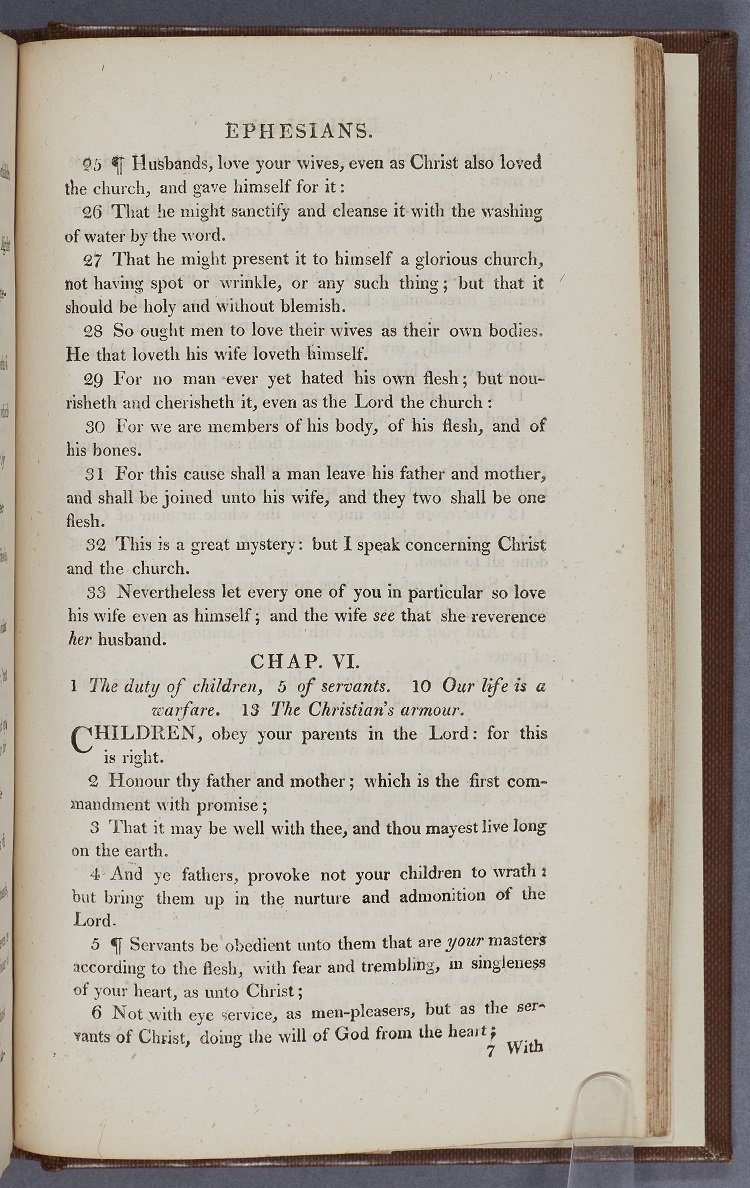
Select sections of the Holy Bible for the use of the Negro Slaves. (London, 1808)
This volume, commonly called the ‘Slave’ Bible, was published on behalf of the Society for the Conversion of Negro Slaves, founded by Bishop Beilby Porteus, who was an advocate of abolition. This version was published the year after trade in enslaved people was abolished and four years after the successful anti-slavery revolution in Haiti.
Whereas a standard protestant Bible contains 1,189 chapters, this version contains only 232. It excludes 90% of the Old Testament, and 50% of the New Testament. Many references to freedom and escape from slavery were removed and some passages encouraging loyalty and submission to masters were emphasised. For instance, the text skips directly from Genesis 45:28 to Exodus 19. It includes the Ten Commandments (Exodus 20), but the first 18 books of Exodus, in which the Israelites escape slavery in Egypt, have been removed.
E198.N3
Anonymous petition addressed to the ‘Lord arch Bishop of London’. 4 August 1723.
This letter, sent from Virginia, is one of the earliest known pleas for freedom by an enslaved person. Created in secrecy over a period of a month, probably using home-made ink, it asks for the freedom of mixed-race enslaved people.
It provides an account of the abusive practices at a plantation. Only a few months earlier, plantation owners in Virginia crushed various plans by enslaved people to secure freedom.
The writer tells us that they are ‘but a poor Slave’ and reveals that they are owned by their own brother. This fact is emphasised by being underlined twice. The writer’s main appeal for emancipation is then followed by a plea for Christian education. Becoming literate and Christian were seen by some plantation owners as acts that undermined the system of enslavement.
The fact that it was addressed to the ‘Lord arch Bishop of London’ demonstrates that enslaved people were addressing their protests and pleas beyond those they were forced to serve. There is no evidence that any response was ever made to this petition.
FP XVII ff. 167-168
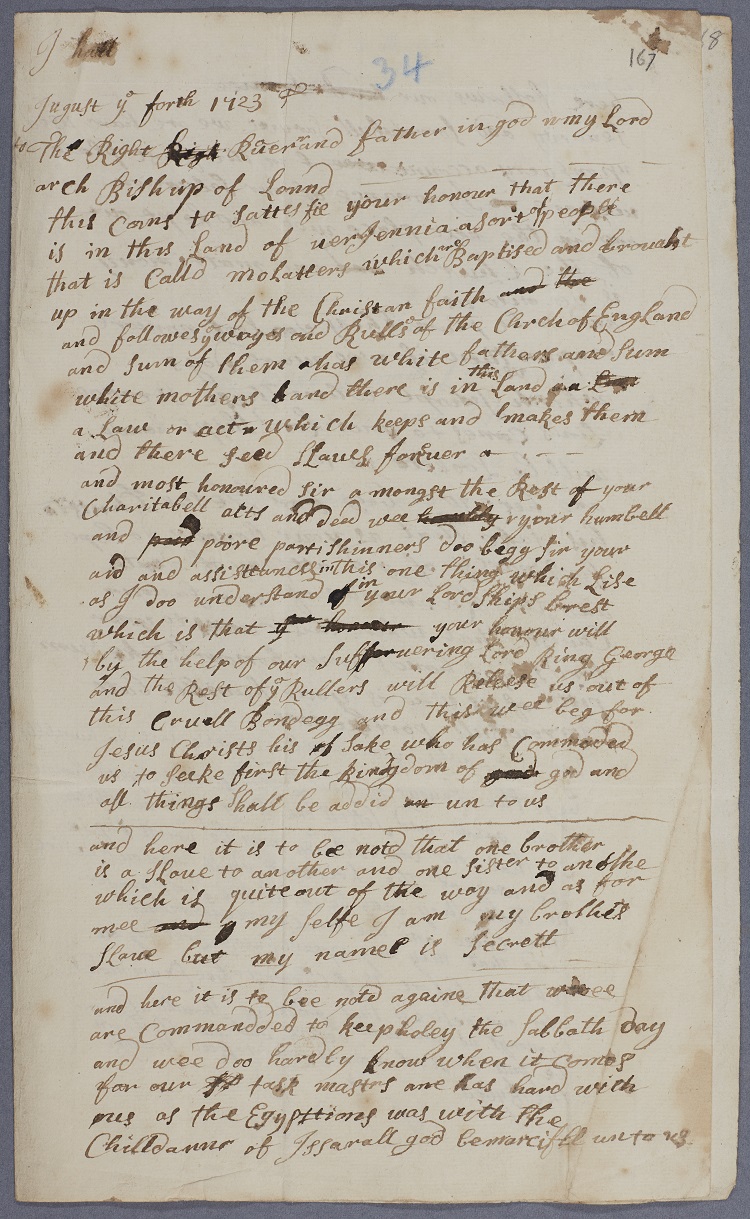
Recording of the Anonymous petition addressed to the ‘Lord arch Bishop of London’. 4 August 1723.
Map from A view of the coasts, countries and islands within the limits of the South-Sea-Company. (London, 1711)
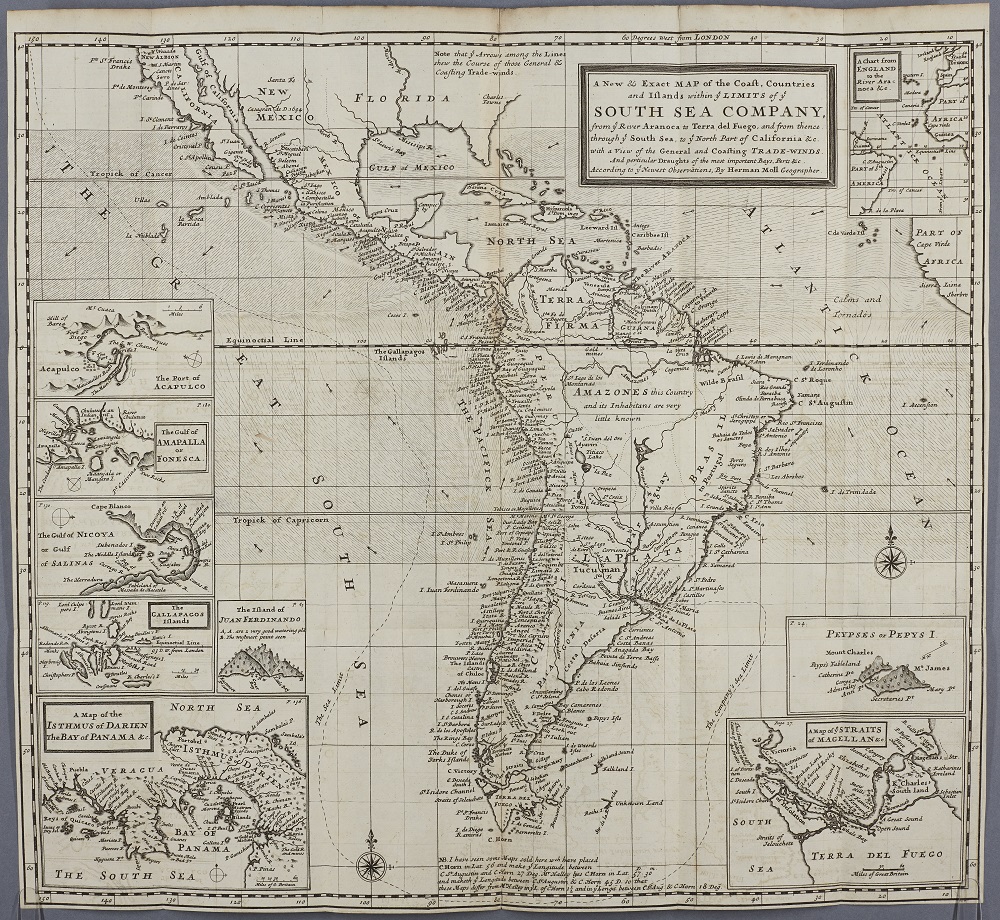
This map is from a book that describes the area of operation of the South Sea Company. It was published in the same year that the Company started its operations.
The South Sea Company was founded to refinance England’s national debt. In exchange, it was awarded a monopoly from 1713 to provide enslaved African people to the Spanish-held ports in the Americas. The South Sea Company became a significant participant in transatlantic chattel slavery as the trade expanded during the early 18th century. Between 1715 and 1739, this was its core commercial activity. Investors in the company would have known that it was trading in enslaved people. Although it ceased trading in enslaved people in 1739, it continued to exist as a company until 1853.
KZ2221.V5 1711
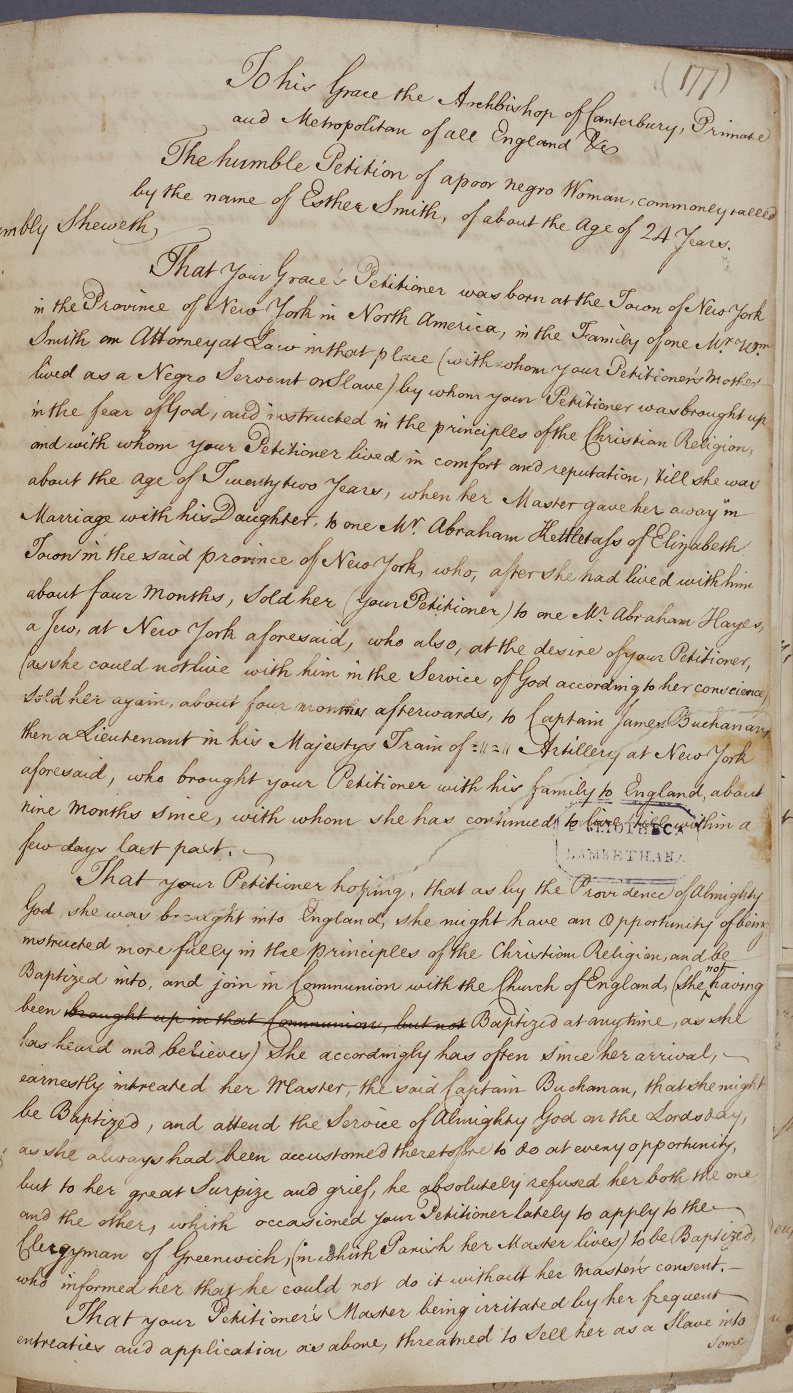
Petition from Esther Smith, a slave, to Archbishop Secker. 19 July 1760.
This petition was written on behalf of Esther Smith. She was born in New York and brought to England by one of her enslavers. The letter documents the number of times she had been bought and sold in her life. In this petition, she is asking to be baptised so that she could,
‘[…] attend the Service of Almighty God on the Lordsday, as she always had been accustomed theretofore to do at every opportunity’.
Esther’s enslaver opposed her baptism. Further correspondence contained within the archives provides a raw account of Esther’s desperation and fears. She tried to obtain baptism at St Alphage’s church in Greenwich, London, and fought to avoid being sent to the West Indies, as confirmed by letters from the church’s vicar Revd Samuel Squire and a Methodist prison visitor Silas Told. Archbishop Secker eventually sought advice from Philip Yorke, 1st Earl of Hardwicke, who confirmed that ‘a slave brought to England is still a slave’ and baptism would not change this status.
Whether Esther succeeded in her efforts remains unknown.
MS 1123/2 item 177
Recording of the Petition from Esther Smith, a slave, to Archbishop Secker. 19 July 1760.
Diagram of the ship ‘Brookes’ from Regulated slave trade: reprinted from the evidence of Robert Stokes. (London, 1849)
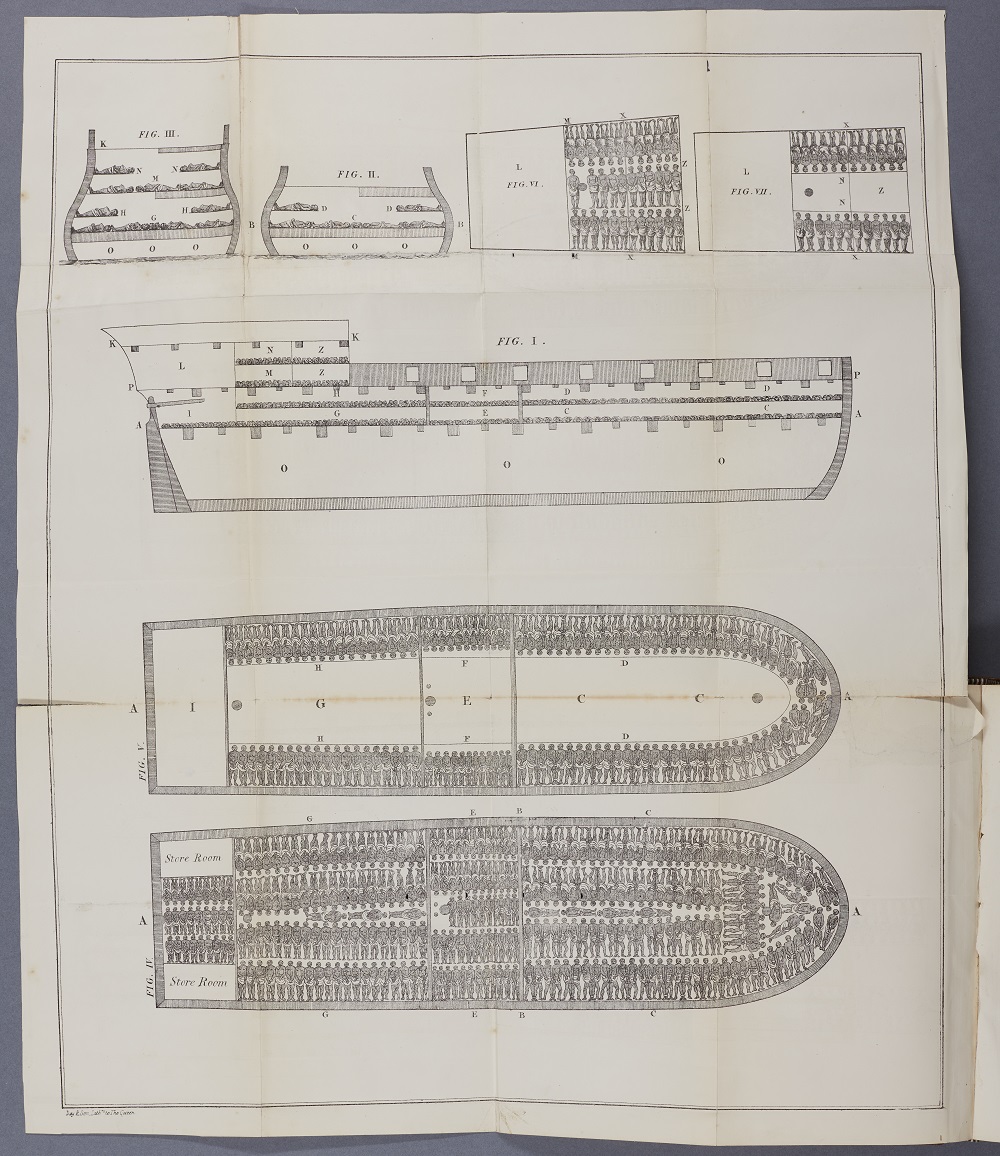
This diagram is of the ship ‘Brookes’ that transported enslaved people between 1781 and 1804. Around 490 people were kept on board in crowded conditions for several months. This illustration of the horrors of the journey across the Atlantic was widely copied and distributed by abolitionists from the 1780s onwards.
MT867 1.04
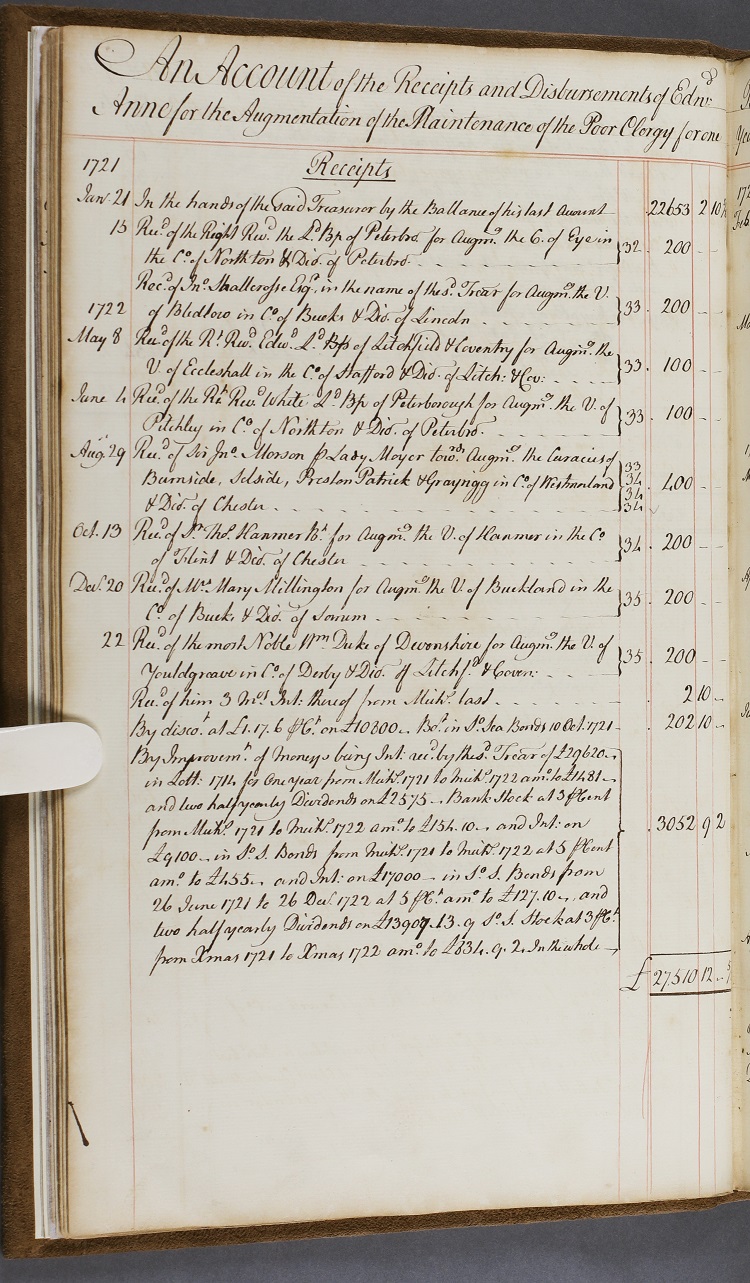
One of the first records of the dividends from the South Sea Company from Queen Anne’s Bounty Accounts Ledger Vol. 1.
This is the first in a series of eight ledgers recording the transactions of Queen Anne’s Bounty. This first volume provides a summary of the accounts from 1708 to 1776.
It includes the Treasurer’s accounts showing receipts and disbursements, listing dates, descriptions and amounts in pounds, shillings and pence. These accounts were examined annually and approved by the General Court of Queen Anne’s Bounty from 1711 onwards. It also contains abstracts and summaries of the accounts as well as details of stock interest amounts received by Queen Anne’s Bounty. One of the first records of the dividends from the South Sea Company, dated 22 December 1721, is visible on the left-hand side of the opening page.
QAB/4/1/1
Entry in Queen Anne’s Bounty Accounts Ledger Vol. 3 showing money received from the executors of Edward Colston.
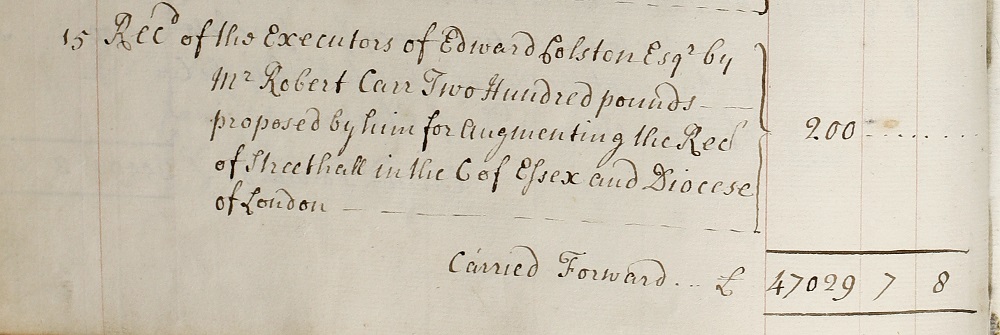
This entry records money received from the executors of Edward Colston, who was heavily involved with the Royal African Company during the period when it held a monopoly on the trade of enslaved people from Africa to the Caribbean. The sum was donated for augmentation of the Rectory of Strethall, Essex, Diocese of London.
QAB/4/1/3
Morgan Godwyn. The Negro’s & Indian’s Advocate. (London, 1680).
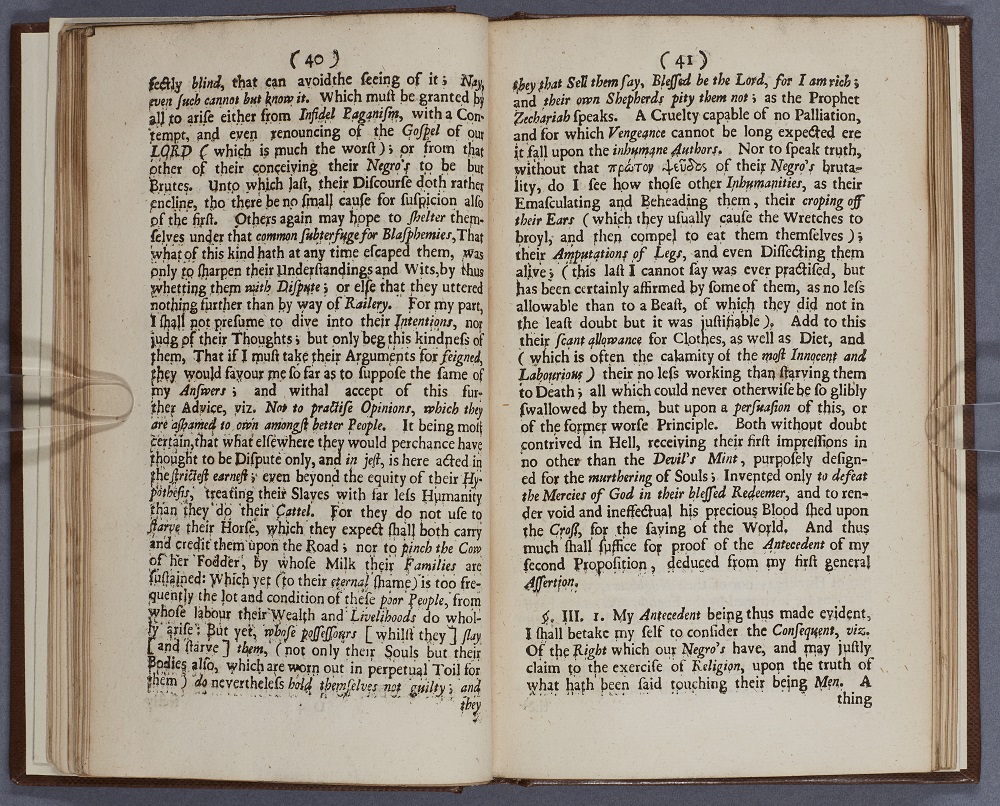
This is one of the first publications encouraging Anglican priests to baptise enslaved people. It was described in the 1880s by the American abolitionist Frederick Douglass as ‘the foundation of all the grand concessions yet made to the claims, the character, the manhood and dignity of the Negro’.
An opponent of slavery, Morgan Godwyn was an Anglican minister who had witnessed the barbarity of slavery in Virginia and Barbados. After returning to England, he published several tracts calling for the conversion of enslaved people to Christianity. Closer reading reveals that his arguments voiced criticism not only of the lack of Christian conversion but of the immorality of both the trade in enslaved people and enslavement itself.
Godwyn’s last published sermon was Trade before Religion. It was addressed to King James II and delivered at Westminster Abbey and other churches across London. He compared enslavement and the trade in enslaved people to a pact with the devil:
‘We have exceeded the worst of Infidels, by our first enslaving, and then murthering of Mens Souls. For how can it be endured that a Nation once so famous for Zeal and Piety… should prostrate her self to that foul Idol Mammon, and worship Trade’.
After preaching this sermon in 1685, Godwyn vanished from historical records.
KY185.7G6

